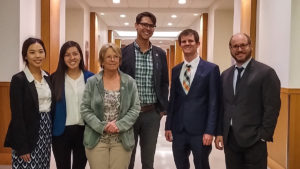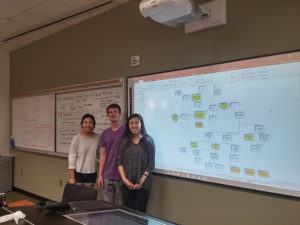
The following guest post was written by Julia Wu and Eric Malmgren, students at the Intellectual Property, Arts, and Technology Clinic at UC Irvine Law. We’re grateful to the clinic students and to their director, Jack Lerner, for all their work in reviewing the Termination of Transfer tool.
The law on termination of copyright transfers is complicated—really complicated. As members of the research team tasked with “vetting” the Authors Alliance/Creative Commons Termination of Transfer Tool, we became acutely aware of just how intricate, technical, and downright maddening this area of law can be.
In 2016, Authors Alliance approached the UCI Intellectual Property, Arts, and Technology Clinic for help launching the Termination of Transfer Tool (“ToT Tool”), an online resource to educate authors about termination of transfers and roughly estimate whether a work is eligible for a termination. They wanted to ensure that the ToT Tool correctly applied the law to estimate copyright duration and the timeframes during which a termination of transfer could be executed.
It’s a cliché, but in this case it fits perfectly: we were thrown into the deep end of the pool, and we had to learn quickly how to swim. Together with fellow clinic member Erica Row, Professor Jack Lerner, and our friends at the Samuelson-Glushko Technology Law & Policy Clinic at Colorado Law, we immersed ourselves in §§ 203 and 304 of the Copyright Act, relevant case law, and treatises such as Nimmer on Copyright.
After extensive research, our team met to map out the logical steps needed to determine whether a given work would likely be eligible for a termination of transfer. Our goal was to create a set of binary (yes-no) questions and simple equations that would reliably predict whether a termination right likely existed and when it could be exercised.  Several of these questions were derived from the Copyright Act, such as whether the copyright was assigned through a last will and testament. If so, it cannot be terminated. Others depended on factors found in important court decisions, such as CCNV v. Reid, which provided guidance as to whether a given work is a “work made for hire” and thus ineligible for termination. Our “map” of termination law became a flowchart the length of a large UCI Law classroom.
Several of these questions were derived from the Copyright Act, such as whether the copyright was assigned through a last will and testament. If so, it cannot be terminated. Others depended on factors found in important court decisions, such as CCNV v. Reid, which provided guidance as to whether a given work is a “work made for hire” and thus ineligible for termination. Our “map” of termination law became a flowchart the length of a large UCI Law classroom.
The most basic analysis of whether a transferred copyrighted work is eligible for termination requires four main dates: the date of the work’s creation, the date of the work’s publication (if applicable), the date of copyright registration (if applicable), and the date of the transfer or assignment. There are ninety-three years between the relevant years of 1923 and 2016. Multiplying ninety-three by itself four times (i.e., 934) results in 74,805,201 possible combinations of those four dates. In light of the millions of possibilities, a flowchart on a whiteboard—no matter how big—would not allow us to evaluate enough scenarios to verify that the ToT Tool accurately analyzed transfer eligibility, so we developed a spreadsheet that mirrored the ToT Tool’s functionality and could be used as an independent verification method—essentially, a parallel tool. As we discovered new and sometimes minor nuances of the termination provisions, we devised ways to address them within the spreadsheet. Over time, our spreadsheet grew more and more intricate.
We found that rather than attempt to review all 75+ million date combinations, we could focus on dates that corresponded to important changes in U.S. copyright law, like January 1, 1978, the date the 1976 Copyright Act went into effect. With these significant dates in mind, we created a list of date combinations that would likely reveal whether the ToT Tool and our spreadsheet correctly addressed the nuances of the termination provisions.
Our work culminated in an afternoon in which we trained fourteen other students in the UCI IPAT Clinic on the use of the Authors Alliance/Creative Commons ToT Tool, and gave each one a list of date combinations to enter into both the Tool and our spreadsheet. Members of the IPAT Clinic processed hundreds of the highest-priority date combinations that we could identify. We gathered the results and analyzed any discrepancies to determine whether the ToT Tool or our spreadsheet accurately predicted the correct outcome. We also met and talked numerous times with Authors Alliance’s then-Executive Director Mike Wolfe, and Professor Pamela Samuelson.
Termination of copyright transfers is a complex and sometimes unsettled area of the law. For the first time ever, the Authors Alliance/Creative Commons Termination of Transfer Tool makes what has been an arcane and inscrutable area of the law accessible to everyone. We are incredibly proud to have contributed to this effort.
Use the Termination of Transfer Tool, read the materials, and if you think you may have a work eligible for a termination of transfer, speak with an attorney who can help you get your rights back.
Eric Malmgren and Julia Wu are J.D. Candidates at the University of California, Irvine School of Law. During the 2016-2017 academic year, they were Certified Law Students in the UCI Intellectual Property, Arts, and Technology Clinic.
Discover more from Authors Alliance
Subscribe to get the latest posts sent to your email.
